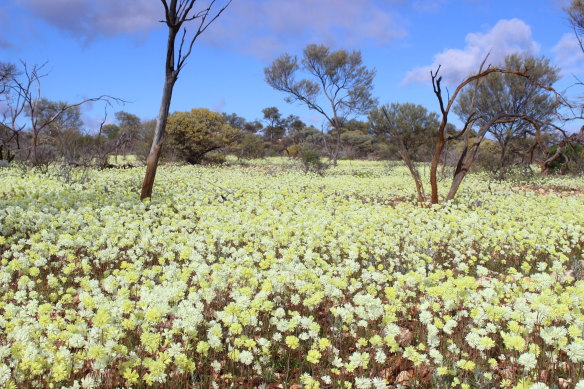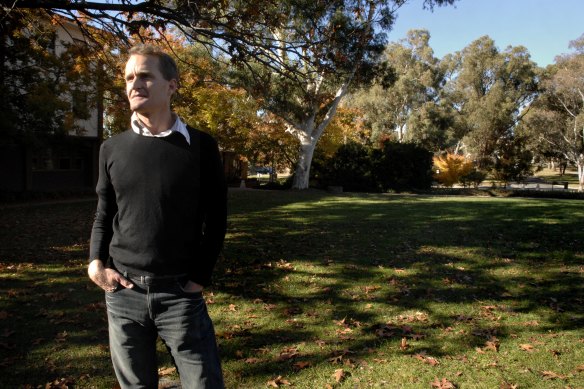This was published 9 months ago
‘It’s almost beyond belief’: Findings blast Australia’s biggest carbon offset scheme
Australia’s biggest carbon credit scheme is barely removing any greenhouse gas from the atmosphere, according to a new study, despite hundreds of millions of dollars being pumped into it by businesses and the government.
One of the study’s authors, Dr Megan Evans from UNSW Canberra, said the findings about the Human Induced Regeneration scheme, known as HIR, pointed to “such huge failures that it’s almost beyond belief”.

Co-author and University of NSW senior lecturer Megan Evans.
The HIR is intended to allow farmers and project proponents to reduce stock and feral animals from vast areas of rangeland Australia which, they argue, allows forest to regrow there in a way it would not otherwise.
Credits are then issued for each tonne of carbon dioxide abated by the assumed growth in trees based on a model of how the forest should regrow in those areas, plus on regular audits.
The new research from a group of ANU and UNSW scientists, led by Professor Andrew Macintosh, used historical and current satellite images to suggest there was no meaningful change between forest growth on areas that were claiming carbon credits compared with neighbouring areas.
The new paper suggests that whatever trees have grown on the 116 projects surveyed was overwhelmingly due to recent rainfall, not the human management of projects.

Australia’s rangelands are highly responsive to rain, as illustrated by the growth of wildflowers.
The study found most projects showed “minimal impact on woody vegetation cover in credited areas” even though they had already generated about $495 million in carbon credits.
Their findings were immediately rejected by another ANU scientist, natural resource management associate professor Cris Brack, who has done extensive work for the government regulator, the Clean Energy Regulator.
Brack rejected the statement that little or no abatement had taken place, saying he had “personally reviewed numerous projects across NSW, Queensland and WA”, and had access to independent assurance-audit reports that proved projects were on track.
The HIR method is the largest single contributor of carbon credits to the Australian government and private industry, with 465 projects covering 42 million hectares – an area significantly larger than Japan. Having issued 44 million carbon credits, the Australian scheme is, according to the new study, the fifth-largest nature-based scheme in the world, making these findings of global significance.

ANU professor of climate change law and policy Andrew Macintosh.Credit: Vikky Wilkes
The problem, the researchers say, is that HIR schemes are being credited on rangeland that was unsuitable because it was never cleared of forest in the first place, and is already close to its natural coverage of forest (trees above two metres tall over at least 20 per cent of the landscape).
Since 2021, Macintosh and a growing team of scientists have described the method as a fraud that would cost Australia up to $5 billion by 2030.
Their concerns have prompted a number of reviews, most notably by former chief scientist Ian Chubb. In 2023, he found the method was sound and said, “we have no reason to believe that there are substantial numbers of [Australian Carbon Credit Units] ACCUs not credible at the moment”.
But the new, peer-reviewed report, published by Macintosh and his team on Friday in The Rangeland Journal, closely analysed 116 sites in NSW, Queensland and South Australia using high-resolution satellite images.
Based on the number of carbon credits generated on the project areas, the tree canopy should have covered 30 per cent of the sites. Instead, they found the average cover was just 13 per cent. They also found the project’s management had made little difference to tree coverage.
“The areas are likely to be at or near their carrying capacity for woody vegetation, meaning any changes in tree cover are most likely to be attributable to seasonal variability in rainfall,” the report said. “Projects are being credited for regenerating forests in areas that contained forest cover when the projects started.
“Given that 2023 was the third year of a rare triple-dip wet La Niña, if the projects were performing as expected, observed levels of canopy cover across the projects would be significantly higher.”
The scientists said the real problem with this was that emitters would not alter their behaviour because they could buy offsets, then if those offsets did not produce real cuts in carbon dioxide in the atmosphere, Australia would not genuinely reduce its emissions.
Another of the project’s authors, Professor Don Butler from the ANU, said the government body that administers the scheme, the Clean Energy Regulator, had “let us all down terribly”.
“They’ve used hundreds of millions of dollars of public money to build a house of cards that is enabling climate inaction ... The failure of this scheme will only become more obvious as time goes on.”
But Brack, who has audited the scheme for the Clean Energy Regulator, and found it was meeting its targets, said the other scientists had got their measurements wrong.
The satellite images they used were not picking up all the extra growth, he said, much of which could only be seen from photographs or “in situation measurements” on the ground.
Brack added that projects could still meet targets if there were small trees that had not yet reached full size.
In a statement, the Clean Energy Regulator said the HIR method had been reviewed and found to be sound, by Chubb, the Australian National Audit Office and most recently by Brack who had given “strong assurance that the projects are being managed properly”.
If a project was not compliant, carbon credits already paid out were clawed back, the statement said. “We only issue carbon credits where a project can demonstrate regenerating native forest,” it said.
Start the day with a summary of the day’s most important and interesting stories, analysis and insights. Sign up for our Morning Edition newsletter.